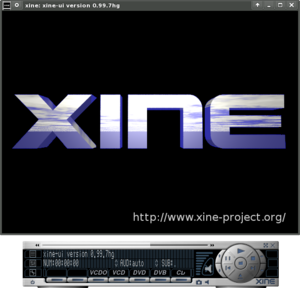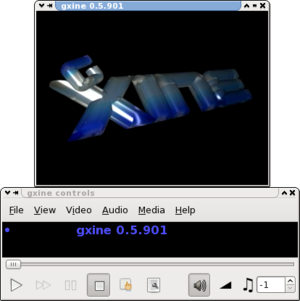Xine
| Initial release | August 15, 2000 |
|---|---|
| Repository | sourceforge |
| Written in | C |
| Operating system | Cross-platform |
| Type | Media player |
| License | GNU GPL |
| Website | xine-project |
| Stable release | 1.2.8 (February 21, 2017) |
|---|---|
| Repository | sourceforge |
| Website | xine-project |
 |
|
| Stable release | 0.99.9 (August 21, 2014) |
|---|---|
| Preview release | none (n/a) |
| Repository | sourceforge |
| Website | xine-project |
 |
|
| Stable release | 0.5.908 (May 10, 2014) |
|---|---|
| Repository | sourceforge |
| Website | xine-project |
| Stable release | 1.0.2 (July 26, 2008) |
|---|---|
| Repository | sourceforge |
| Website | xine-project |
xine /ˈksiːn/ is a multimedia playback engine for Unix-like operating systems released under the GNU General Public License. xine is built around a shared library (xine-lib) that supports different frontend player applications. Another important feature of xine is the ability to manually correct the synchronization of audio and video streams. xine uses libraries from other projects such as liba52, libmpeg2, FFmpeg, libmad, FAAD2, and Ogle. xine can also use binary Windows codecs through a wrapper, bundled as the w32codecs, for playback of some media formats that are not handled natively.
xine was started in 2000 by Günter Bartsch shortly after LinuxTag. At that time playing DVDs in Linux was described as a tortuous process since one had to manually create audio and video named pipes and start their separated decoder processes.
Günter realized the OMS (Open Media System) or LiViD approach had obvious shortcomings in terms of audio and video synchronization, so xine was born as an experiment trying to get it right. The project evolved into a modern media player multi-threaded architecture.
During xine development, some effort was dedicated to making a clear separation of the player engine (xine-lib) and front-end (xine-ui). Since the 1.0 release (2004-12-25) the API of xine-lib is considered stable and several applications and players rely on it.
...
Wikipedia
